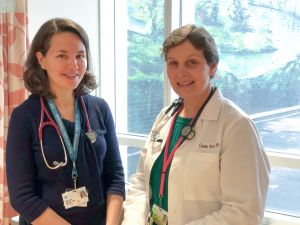October 9, 2019
October 9, 2019

It is normal to be scared when you find a breast lump, but not necessarily a finding of concern. Schedule an appointment to be seen by your primary care provider.
Although 80% of breast lumps found by women are not cancerous, it is still important to have any new and persistent breast lump checked out. Don’t ignore a new lump in your breast.
I encourage everyone to know their own bodies and to perform monthly self-breast exams to detect any changes that may need to be evaluated. If that breast lump turns out to be breast cancer, early detection can save your life.
Benign breast lumps usually have smooth edges and move easily when you touch them. They are often found in both breasts. There are several factors that can cause benign breast lumps, including normal changes in breast tissue, breast infection, injury, breast cyst, fibroadenoma, intraductal papilloma, and traumatic fat necrosis. Some of these factors are highlighted below:

Normal changes in breast tissue: Breast tissue responds to hormone changes particularly around the menstrual cycle. During normal monthly menstrual cycles some women have fibrocystic breast changes. This means that they have lumps in both breasts that increase in size and tenderness just before their periods. These lumps are normal breast tissue or cysts which have become enlarged or irritated in response to cyclic hormone changes. They usually become less prominent and tender after the period ends.
Breast infection: Sometimes a painful lump, with or without redness, is the first sign of infection. Abscess tends to occur in small pockets that are warm and tender to touch. Symptoms usually worsen quickly. Applying warm compresses can be helpful, but you may also need antibiotics to treat this.
Breast injury: A bump to the breast can cause bruising or an underlying blood clot (hematoma). These lumps tend to occur in response to a known injury and are associated with the “black and blue” color changes characteristic of bruising. Hematomas can take a long time to heal.
Simple cysts: Simple cysts are fluid-filled sacks that are usually found in both breasts. They can vary in size and tenderness particularly around the menstrual cycle. The number of cysts vary from one to many. Breast cyst development tends to run in families.
Fibroadenomas: These lumps tend to occur in women between the ages of 20 and 30. They are more common in African-American women. A fibroadenoma forms when the breast makes extra milk-forming glands. This causes development of a solid, round, rubbery lump in the breast that freely moves when touched. There can be one or many of them.
Cancer is the most concerning cause of a breast lump. A cancerous mass in the breast will continue to get bigger and ultimately can cause disfigurement of the breast. Breast cancer can also spread to other parts of the body and vital organs making it life threatening.
The good news is that breast cancer can be found in the early stages when treatment and cure are possible. For this reason, it is vitally important for you to watch for the warning signs of breast cancer and report them immediately to your health care provider. Be aware of any changes in the look or feel of the breast, the nipple, or the development of nipple discharge.
The warning signs of breast cancer include:
- A lump, hard knot or thickening of the breast or underarm area.
- Swelling, warmth, redness or darkening of the breast.
- Change in the size or shape of the breast.
- Dimpling or puckering of the skin.
- Itchy, scaly sore or rash on the nipple.
- Distortion of the nipple or other parts of the breast.
- Nipple discharge that starts suddenly or is bloody.
- New pain in one spot of the breast that does not go away.
If you have any of these breast changes, seek care immediately.
This is Breast Cancer Awareness Month. I encourage you to consider things that contribute to breast health. Once you turn 20, you should check your breasts every month, usually the week after your period. In this way you can become familiar with your breast tissue and more easily recognize any changes that occur. Your health care provider may also recommend a clinical breast exam (done by your provider) every 1-3 years starting at 20.
As you get older, get a mammogram. Expert organizations disagree on the timing and frequency of mammograms, so it is best to discuss this with your health care provider.
Consider having a first mammogram at the age of 40 (or earlier if you have a family history or a first-degree relative developed breast cancer at a young age), then a mammogram every 1-2 years (www.uspreventativeservicestaskforce.org) between the ages of 40 and 50, and annual mammograms between the ages of 50 and 75.
Screening mammograms can identify breast cancer at an early stage, even before it has created a palpable mass or other symptoms in your breast. Early detection saves lives.
—
Glenda Flynn, advanced oncology nurse practitioner at the Mass General Cancer Center at Cooley Dickinson Hospital, wrote the above article for Breast Cancer Awareness Month.

